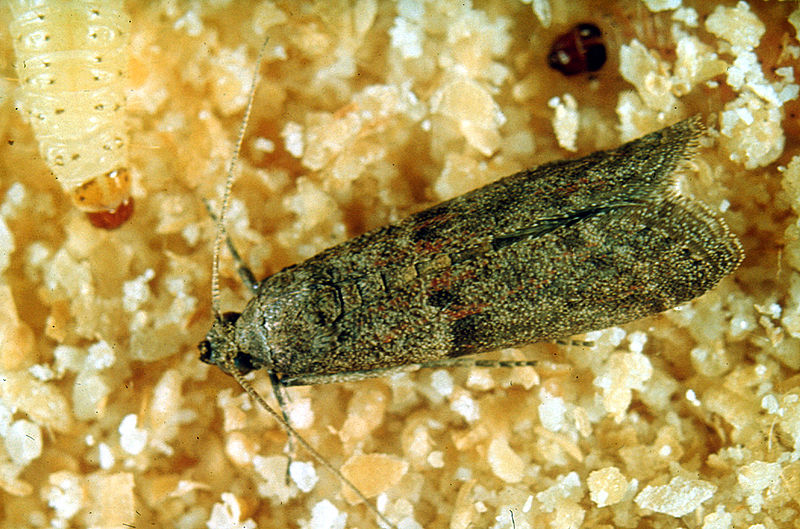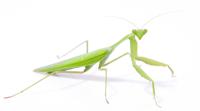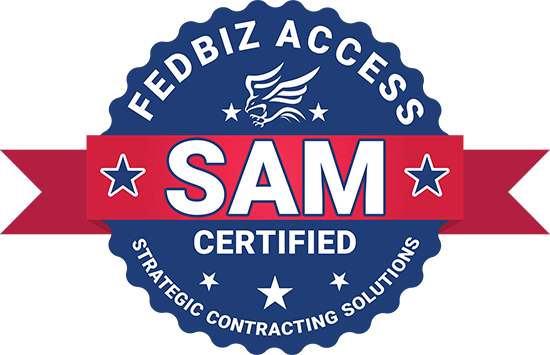Description:
 The almond moth will feed on a variety of grain and seeds, as well as other dry goods like fruit and pet food. You may also find the moth in coarse flour and cornmeal. Almond Moth goes by the nicknames “Cocoa Moth” and "Warehouse Moth". The almond moth infests stored products and the adults can fly. You will be able to tell if you have an almond moth infestation if you see them flying around where dry food is stored. This will often be during the later hours of the day, starting at dusk. Larvae will stay on the food item until it is ready to pupate, often crawling to the ceiling of the container to make its cocoon. In foods stored in cardboard boxes, for example, you might notice small holes in the sides from where the larvae began to munch. In contaminated items, there will often be silk-like webbing if the moth is present, so be sure to look carefully before you eat. A sign of infestation in the product is contamination with silk webbing, frass, cast skins, pupal cases and adult remains. Almond moths are common in warehouses that provide storage for food product. This cosmopolitan moth will feed on many species of nut, such as almonds, walnuts, peanuts, hazelnuts and many more. They will also feed on dried fruit, figs, dates, cocoa beans, seeds and grains. Is found worldwide, but it can only overwinter inside heated structures in temperate areas.
The almond moth will feed on a variety of grain and seeds, as well as other dry goods like fruit and pet food. You may also find the moth in coarse flour and cornmeal. Almond Moth goes by the nicknames “Cocoa Moth” and "Warehouse Moth". The almond moth infests stored products and the adults can fly. You will be able to tell if you have an almond moth infestation if you see them flying around where dry food is stored. This will often be during the later hours of the day, starting at dusk. Larvae will stay on the food item until it is ready to pupate, often crawling to the ceiling of the container to make its cocoon. In foods stored in cardboard boxes, for example, you might notice small holes in the sides from where the larvae began to munch. In contaminated items, there will often be silk-like webbing if the moth is present, so be sure to look carefully before you eat. A sign of infestation in the product is contamination with silk webbing, frass, cast skins, pupal cases and adult remains. Almond moths are common in warehouses that provide storage for food product. This cosmopolitan moth will feed on many species of nut, such as almonds, walnuts, peanuts, hazelnuts and many more. They will also feed on dried fruit, figs, dates, cocoa beans, seeds and grains. Is found worldwide, but it can only overwinter inside heated structures in temperate areas.
Photo attribution link: CSIRO [CC BY 3.0 (http://creativecommons.org/licenses/by/3.0)], via Wikimedia Commons
Appearance:
The body is 7.5 – 10 mm long the adult almond moth has a wing span of 19 mm. The forewings are grey to dusty brown. The larvae is white to pink in color and has a distinctive brown head, there is a dark straight band across the forewing, which is paler on the inner edge.
Lifecycle:
The female lays 150 - 200 eggs loosely and randomly on a food source. The larva can grow to 12.7 mm in length. When the larva is mature it will actively leave the food source and search for a site in which to pupate. The larva pupates in a silk cocoon.
Habits:
The almond moth is found worldwide in processing facilities, warehouses and households. It feeds on grain, cereal products, oilseeds and dried plant products, like nuts, fruit and tobacco. The larva burrows into food and creates silk tunnels in which it will be concealed while feeding. Large larva can burrow through packing.






